To add seriousness to themselves, they faked their pedigree. To earn, they did not hesitate to betray. They included eminent leaders and great politicians, but also ordinary losers, scandalists and freaks. A cursed family whose crown dreams never came true.
Genealogists at the service of the family derived the beginning of the family from the Lithuanian prince Narymunt and his son, the pagan high priest Lizdejko. In reality, however, the Radziwiłł family were not a duke's family. They came from the boyar dynasty and only with time - thanks to persistence, thrift, and sometimes less honest endeavors - did they come to importance, property and the title of duke.
Working with the Jagiellonians in the 15th century, they joined the Lithuanian elite and never let themselves be pushed out of it. Radziwiłł's appetites grew so much that at some point they even wanted to reach for a grand-ducal or royal crown and become rulers . And they almost succeeded. As Witold Banach writes in his book entitled "Radziwiłłowie. The turbulent fate of the famous family ” :
The Radziwiłłs could and should become the heroes of Galsworthy's "Forsyte Saga" (...) The epic potential of the Radziwiłł family history, unfulfilled in literature, would be even greater to a large extent, it was an excellent material for a monumental film work in which, through the history of the family, it is possible to show the Polish fate on a global scale (...) .
Who were the members of the most powerful family in the history of Poland?
The founding fathers, or rather ordinary nobles
The first known progenitor of the family was Ościk from Kiernowo. At the congress in Horodło in 1413, he was admitted to the coat of arms of Trąba by the archbishop of Gniezno, Mikołaj Trąb. He collected considerable fortune from the grants of the Grand Duke and his own colonization action. His son - Radziwiłł Ościkowicz - bore the name, which later became the surname of the entire family.
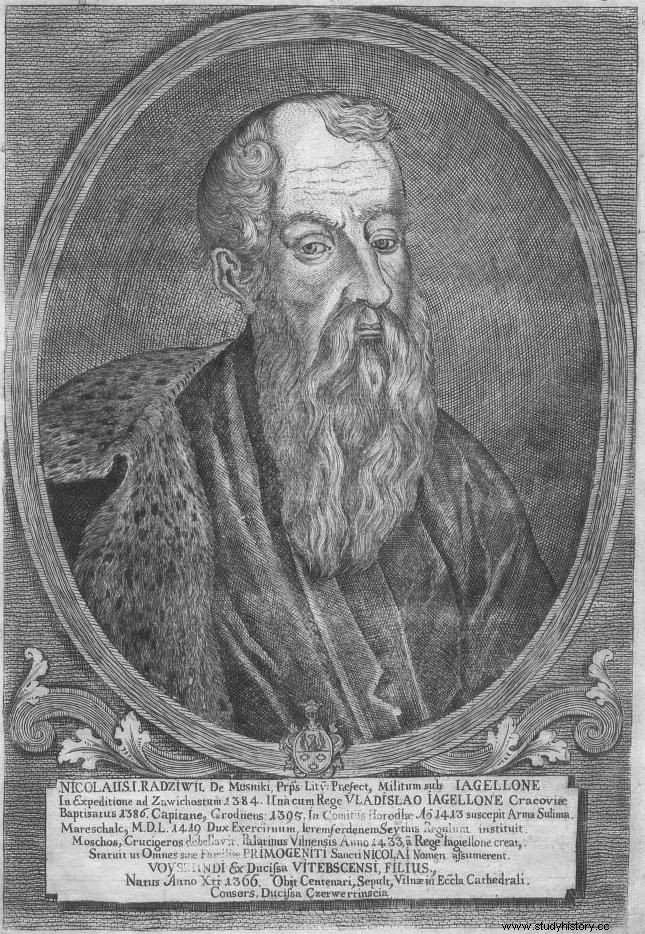
By the act of the Union of Horodel in 1413, the coat of arms of Trąba was transferred to Lithuania. He was received by the boyar Krystyn Ościk from Kiernów (in the picture), adopted by the archbishop of Gniezno, Mikołaj Trąb. His son Radziwiłł, from whom the family took its name, did not come from princes, but from ordinary nobility ... A large purse, however, could change history.
He made a much greater career than his father:he became the court marshal, and then the voivode of Trakai and the castellan of Vilnius. He was such a significant figure in Lithuania that during the attempted anti-Jagiellonian coup in 1452, the possibility of placing him on the grand-ducal throne was considered instead of Kazimierz Jagiellończyk.
He accumulated such a huge fortune that historians refer to his landed estate as a latifundium. However, the real tycoon became Radziwiłł's son - Mikołaj Radziwiłłowicz, who reached the highest offices in Lithuania.
As the Lithuanian chancellor and the Vilnius voivode, he headed the council of Lithuanian lords and exerted a significant influence on the appointment of the grand-ducal throne, first by Alexander Jagiellon, and then by Zygmunt. He multiplied - and so huge already! - fortune, thanks to his wife's rich dowry, new grants, purchases and profitable exchanges.
His daughter Anna married the Duke of Mazovia, Konrad III the Red. In turn, one of the sons of Mikołaj Radziwiłłowicz - Wojciech - became the first priest in the family and achieved the highest church office in Lithuania, the bishop of Vilnius. The other three sons shared their property and started three branches of the family, which at that time was becoming the most powerful family of Poland at that time .
Imperial title for little betrayal
The eldest of the sons of Mikołaj Radziwiłłowicz, born in 1470, Mikołaj Radziwiłł, was the founder of the line in Goniądz and Medelach. Like his father, he held the two most important offices in Lithuania:the Lithuanian chancellor and the Vilnius voivode. He was a strong supporter of maintaining ties with the Crown, which is why in Lithuania he was maliciously nicknamed "Amor Poloniae" - and in Lithuanian lips it was by no means a compliment.
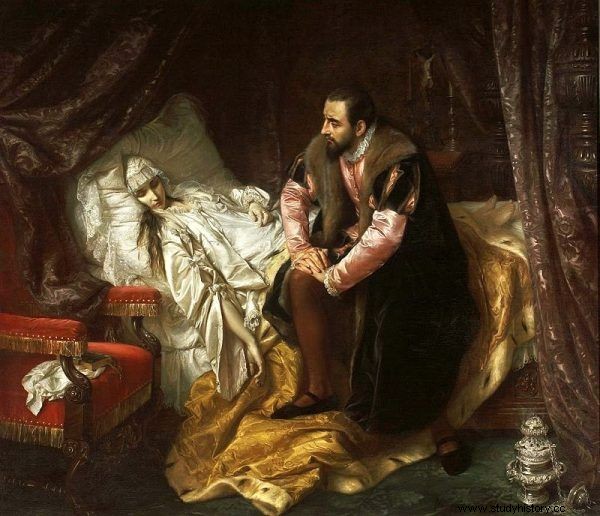
Out of their lust for influence, the Radziwiłłs did not stop at anything. The two Nikolaevs, in order to seize power, offered the then king their relative, Barbara. However, not everything went according to their wishes. The illustration shows the painting by Józef Simmler "The Death of Barbara Radziwiłłówna" (1860).
Its importance in the politics of the Republic of Poland at that time is evidenced by the fact that he took part in the congress of the Habsburgs and Jagiellons in Vienna in 1515, at the head of the Lithuanian delegation. As Stanisław Mackiewicz writes in his book "The Radziwiłł House", during the Mikołaj congress, he wanted to meet Emperor Maksymilian personally. To win him over as an ally in his game with the Jagiellonians, he offered him the title of Prince of the Reich. Nicholas refused. But only at the beginning… And so the Polish magnate became a great lord.
Radziwiłłowie-pęczyciele
Two of the most powerful magnates in Lithuania at the time were able to combine the Radziwiłłs with the Jagiellons:Mikołaj called "the Red" (from the color of his beard) and his cousin, Mikołaj called "Black". In order to obtain a favorable decision of King Sigismund Augustus as to their property claims, they did not hesitate to go to ... pimping.
They decided to "introduce" the ruler - for explicitly sexual purposes - the pretty sister of "Rudy", Barbara. And when they found the couple at an intimate meeting, they forced Zygmunt to get married immediately secretly (read more about it HERE). What was supposed to be a little romance unexpectedly turned into a great political row. In love without memory, the ruler revealed his relationship with Radziwiłłówna and, contrary to public opinion, led to her coronation. The case of the secret marriage caused a scandal and indignation of the nobility in Poland, which threatened with a civil war.
Both Radziwiłłs were accused - rightly so - of conspiracy and deliberate wrapping around the king. On the other hand, the Mykolaiv triumphed:finally, the Radziwiłłs made a marriage with the Jagiellonians! The whole action brought them other benefits as well. In 1547, thanks to the support of Sigismund Augustus, Emperor Charles V granted Nicholas "the Red" the title of prince in Birż and Dubinki, and Mikołaj "Czarny" - the title of prince in Ołyce and Niewia.
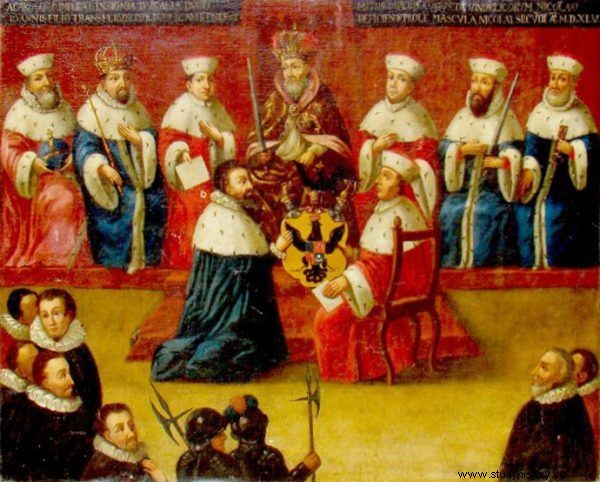
Mikołaj Radziwiłł "Czarny", assuming the duke's title from the emperor. His biggest dream came true. He did not suspect, however, that he would be attacked by a disease that would lead to his death shortly thereafter. Who knows, maybe it was a punishment for early scheming?
However, fate punished the tricky Radziwiłłs:Barbara died six months after the coronation, while Mikołaj "Czarny" fell ill with a painful gout. A Jewish doctor recommended that he use mercury to ease the pain. However, the toxic measure acted quite the opposite - the suffering of "the Black" intensified so much that, as the Apostolic Nuncio to Poland, Giovanni Francesco Commendone wrote in a letter from 1565, his eyes, ears and mouth burst first, then his sides were split open, and finally the head split into two parts so that, abandoned from God, he gave up his ghost with a terrible howl ... "
The Mummy's Curse
Mikołaj Radziwiłł, known as the Orphan, went down in history as a madman, born in 1549, the progenitor of the Niaśviž branch of the family, which is the only one of the three who lives to this day. Raised in Calvinism, he converted to Catholicism and fought against the Reformation. During his illness in 1575, he made a vow to make a pilgrimage to the Holy Land.
He kept his promise:in 1582 he left Nesvizh for Palestine, and then visited Egypt. Among the various souvenirs he took home were also ... two mummies. Unfortunately, on the way back the prince, terrified by a powerful storm (supposedly a curse for the exhibits taken), ordered them to be thrown into the sea ...
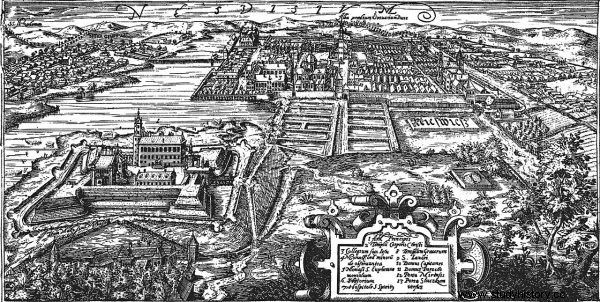
Niasviž was in the hands of the Radziwiłł family as a result of a lucrative marriage. It was inherited by Mikołaj, known as the Black, from his mother Anna of Kiszków, who put him in the position of Jan. However, Mikołaj "Sierotka" Radziwiłł made it a real magnate city.
And again a hair from the crown…
Janusz Radziwiłł - Grand Hetman of Lithuania, Vilnius voivode and ... traitor. Meritorious in the military and diplomatic service for the Republic of Poland, after the Swedish attack on Poland in 1655, he signed a political agreement with them. This meant breaking the union and making Lithuania a separate state ruled by Radziwiłł. In this way, the dream of many representatives of this ambitious Lithuanian family almost became a reality. Almost, because the power of prince Janusz did not last long.
The mood in the Commonwealth turned and the nobility turned against the Swedes. Deprived of the help of protectors, attacked by opponents, the prince died in 1655 in the castle in Tykocin. His cousin, prince Bogusław, could now reach for the crown of the Commonwealth. During the Swedish Deluge, he supported Janusz, but then he repented properly and obtained the forgiveness of King Jan Kazimierz. He gained popularity among the nobility again - so much that he was put forward for the election in 1669. He lost to Michał Korybut Wiśniowiecki. Once again the crown slipped from the hands of the power-hungry Radziwiłłs .
Rich and stupid
But who was the famous, born in 1734, Karol Stanisław Radziwiłł, called "Mr. Lover"? He was a fabulously wealthy loser (apparently he was one of the richest people in Europe at that time!), Who with a light hand spent enormous sums on frills and whims.
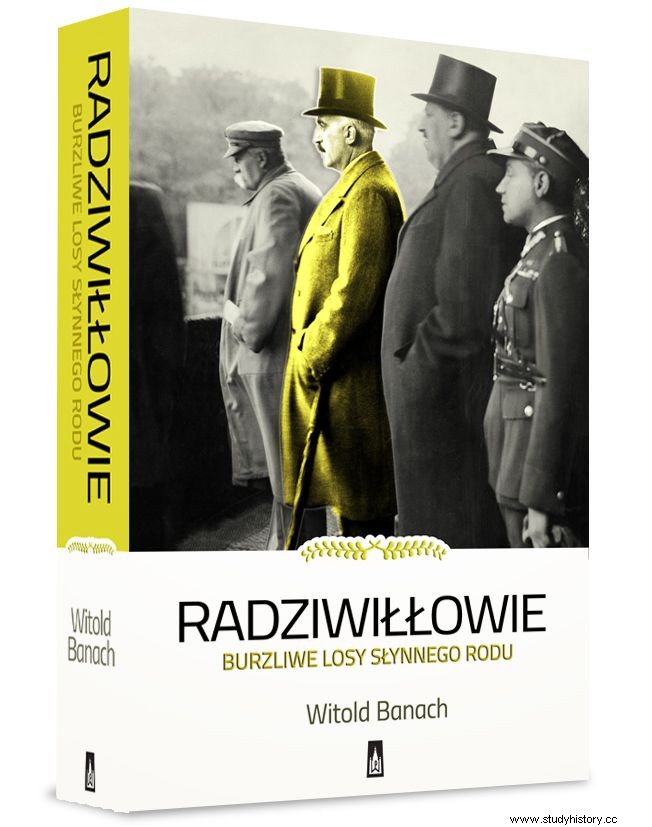
The article was inspired by Witold Banach's book Radziwiłłowie. The stormy fate of a famous family "(Poznań Publishing House 2018) telling the story of one of the most powerful families in the history of Poland.
No less "plentiful" than his own purse, he had his imagination. What it was for him to get into the enemy camp! As he said, when once during a war expedition in Spain, he fell into the hands of enemies, he immediately entered a cannon barrel aimed at his own camp. When it was fired, the prince returned to his own safe and sound . You can? As you can see, the Radziwiłłs could do everything. Well, almost…
He couldn't satisfy his wife
Karol Stanisław's half-brother was Hieronim Radziwiłł. In 1775 he married the beautiful German princess Zofia Thurn und Taxis. Nine years after her marriage, she caused a high-profile marriage scandal. Here she got into an affair with a musician named Duszek, residing in Nesvizh, with whom she ran away, taking all the jewels.
When Jerome found out about his wife's departure, he immediately organized a chase. He caught up with fugitives in Prussian Tilsit and led to their arrest. The princess, however, did not intend to return to her husband at all. She left him and led a free life, repeatedly engaging in love relationships and compromising mesallies. As prince Radziwiłł thoughtfully stated, "Lord Lover", " she had too large a heart to be filled by only her spouse ... ”
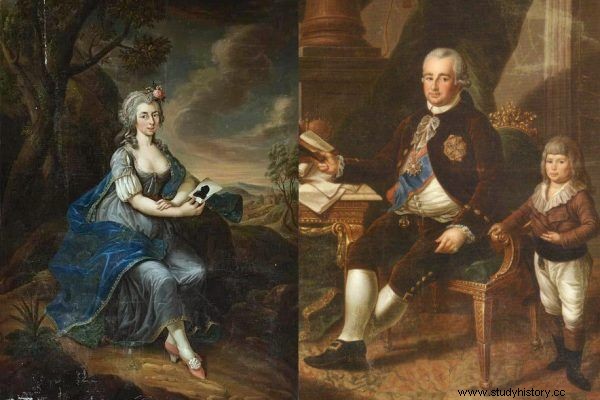
It was rare for the wives to leave the Radziwiłłs. More often it was they who changed spouses like gloves or kept their mistresses. However, Hieronymus was not enough (right) for the German Princess Sophia (left in the picture).
Woman or motherland? What a simple choice…
The partitions of Poland caused the political power of the Radziwiłłs to collapse. However, their role in national history has not ended. Dominik Radziwiłł, born in 1786, was famous for his boisterous lifestyle, full of romance and madness. He had an illegitimate son and a married daughter. In 1811, at the age of 26, left his family, formed a regiment of lancers with his own money and joined the army of the Duchy of Warsaw . He took part in an expedition to Moscow, and Bonaparte himself praised him.
Princess Ludwika of Prussia wrote in her diaries the following opinion about him:"The most courageous and brave of all Poles." As Napoleon's end drew nearer, Dominic was advised to abandon the ranks and return to his ancestral Nesvizh. He then replied, "My place is at the head of my regiment, not in Niasvizh." I wonder if the wife left without money with the children thought the same ... The patriot prince died in the battle of Hanau 2 years later.
For Poland
Janusz Radziwiłł also acted for the rebirth of Poland - this time in the field of diplomacy. In 1918 he became the director of the Department of Political Affairs in the government of Jan Steczkowski created by the Regency Council. The department was something of a ministry of foreign affairs and dealt with, inter alia, negotiations on the emerging Polish army and promoting the idea of an independent Poland.
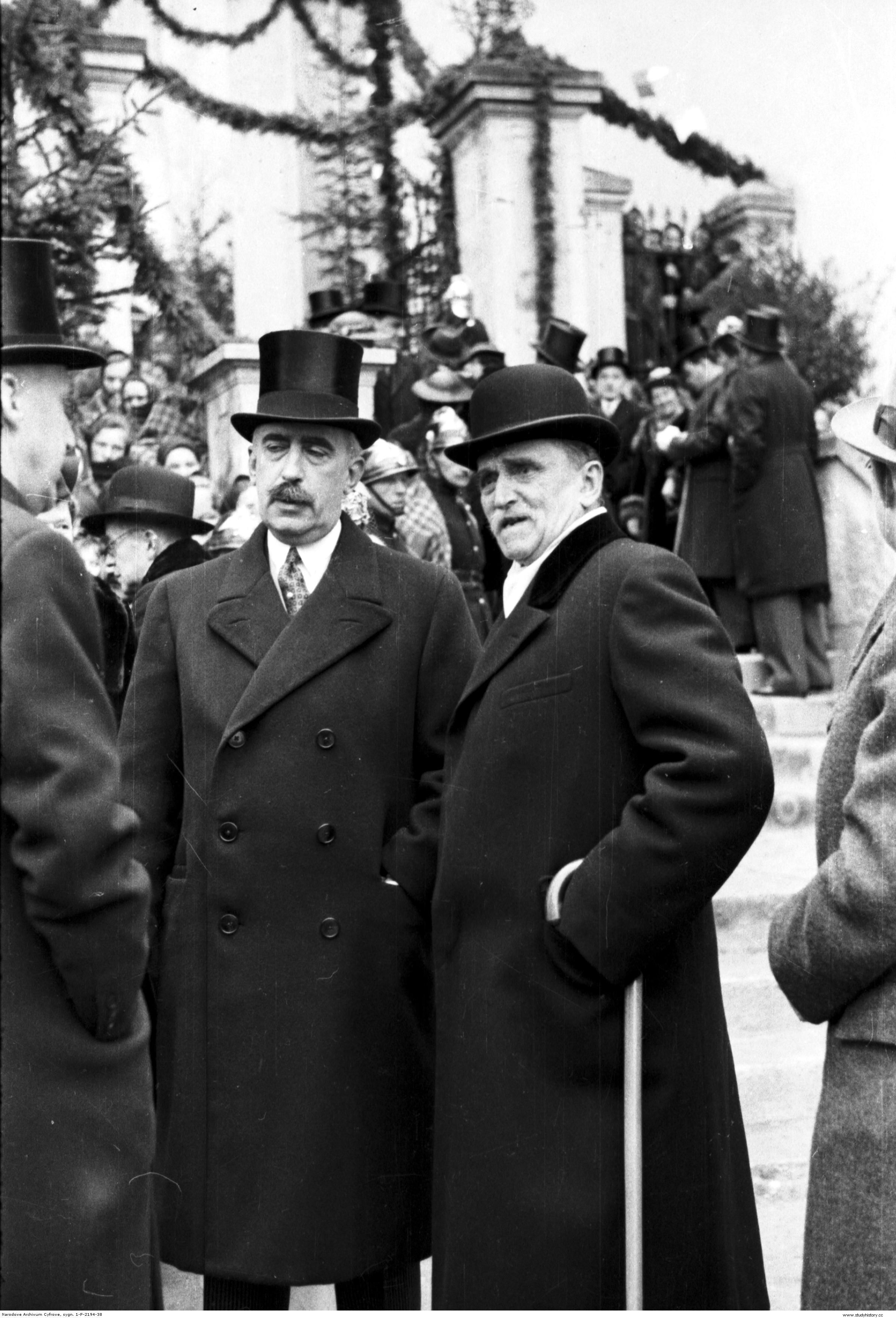
Among the Radziwiłłs there were not only traitors, madmen, losers and pimps. The most powerful family in the history of Poland also produced prominent politicians and patriots such as Janusz Radziwiłł, who did not hesitate to intervene with Göring to free the professors of the Jagiellonian University who were imprisoned during the war. In the photo on the left with Prince Zdzisław Lubomirski (on the right) from 1938.
It was Janusz Radziwiłł who sent a letter to the German chancellor on October 7, 1918, demanding the release of Józef Piłsudski, held in the Magdeburg fortress. Janusz's father - Ferdynand Radziwiłł - on February 10, 1919, as the senior marshal, opened the first session of the reborn Polish Sejm in Warsaw.
World Citizens
As we can read in the book by Witold Banach entitled "Radziwiłł. The turbulent fate of the famous family ” :
The Radziwiłłs were citizens of the world in the fullest sense of the word. They had their estates, palaces and houses in Poland, Russia, Germany, France and Italy. They were friends of kings, emperors, tsars, ministers, ambassadors and… the president of the USA . Their stories wrote so colorful stories that their presentation could be a fascinating saga in which we will find everything necessary for a great panoramic story .
And this story did not end with Poland regaining independence. The rest of the Radziwiłł's history unfolded in the face of great history. The one written by Katyn, as well as the one whose pages were opened by the presidency of John Fitzgerald Kennedy, who was the brother-in-law ... Radziwiłła!
